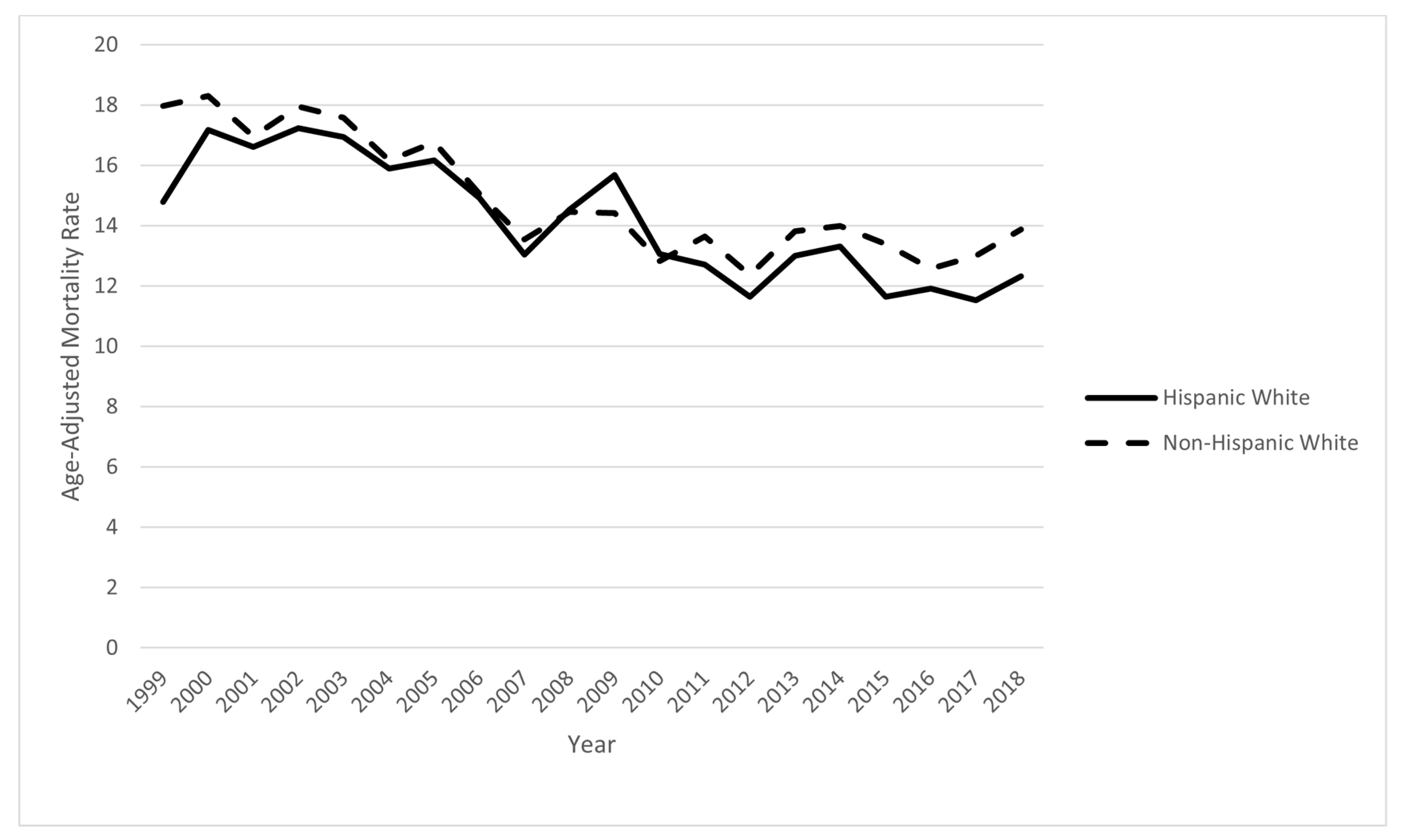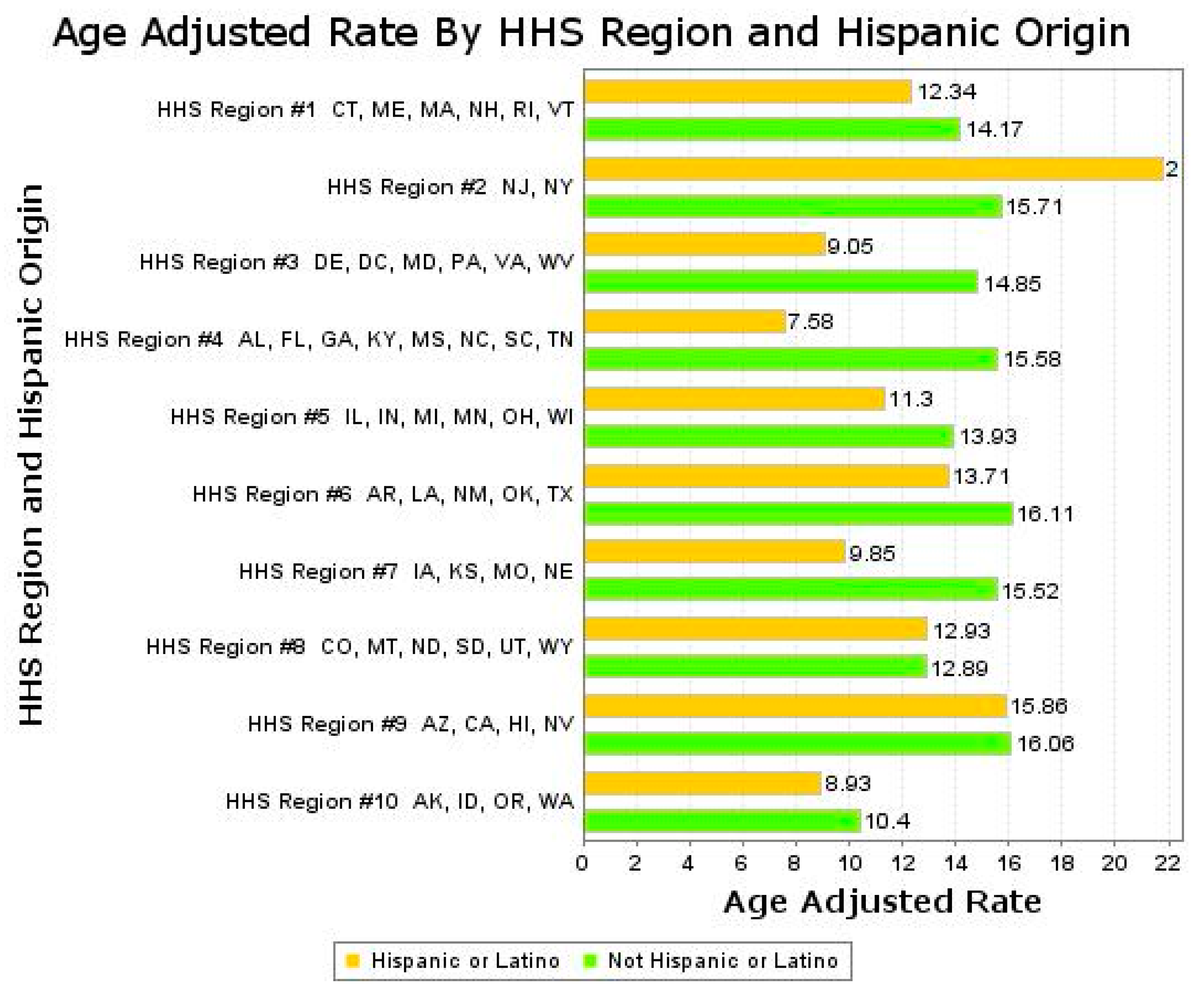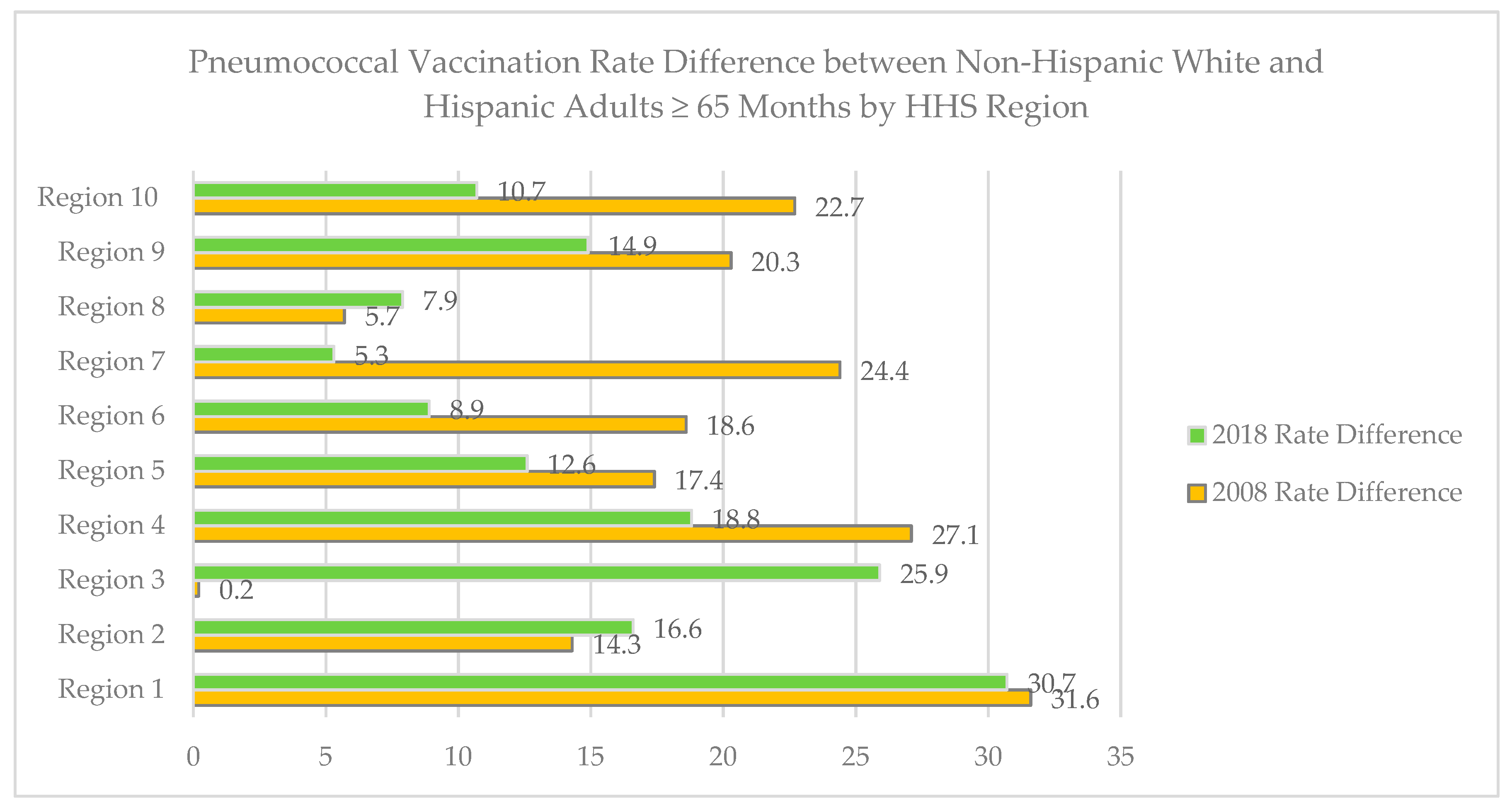Geographic Heterogeneity in Influenza and Pneumonia Mortality in Hispanic Americans
Abstract
1. Introduction
2. Materials and Methods
2.1. Population and Deaths
2.2. Regions and Urbanization
2.3. Immunization
2.4. Analysis
3. Results
3.1. Ethnicity and Death Rates
3.2. Regions and Urbanization
3.3. Immunization
4. Discussion
4.1. Previous Studies
4.2. Strengths and Limitations
5. Conclusions
Supplementary Materials
Author Contributions
Funding
Institutional Review Board Statement
Informed Consent Statement
Data Availability Statement
Conflicts of Interest
References
- National Center for Health Statistics. Health, United States 2018 Chartbook; National Center for Health Statistics: Hyattsville, MD USA, 2019; p. 65. [Google Scholar]
- Hausmann, L.R.; Ibrahim, S.A.; Mehrotra, A.; Nsa, W.; Bratzler, D.W.; Mor, M.K.; Fine, M.J. Racial and Ethnic Disparities in Pneumonia Treatment and Mortality. Med Care 2009, 47, 1009–1017. [Google Scholar] [CrossRef] [PubMed]
- Pickle, L.W.; Mungiole, M.; Jones, G.K.; White, A.A. Atlas of United States Mortality; National Center for Health Statistics, Centers for Disease Control and Prevention, U.S. Department of Health and Human Services: Hyattsville, MD, USA, 1996. [Google Scholar]
- Centers for Disease Control and Prevention; National Center for Health Statistics. Multiple Cause of Death, 1999–2018 Request [Internet]. Available online: https://wonder.cdc.gov/mcd-icd10.html (accessed on 2 December 2020).
- Ingram, D.D.; Franco, S.J. 2013 NCHS urban–rural classification scheme for counties. Natl. Cent. Health Stat. 2014, 2, 81. [Google Scholar]
- Centers for Disease Control and Prevention. Influenza Vaccination Coverage: FluVaxView. [Internet]. National Center for Immunization and Respiratory Diseases, Centers for Disease Control and Prevention. December 2020. Available online: https://www.cdc.gov/flu/fluvaxview/index.htm (accessed on 2 December 2020).
- Norris, T. Vaccination Coverage Among Adults Aged 65 and Over: United States, 2015. NCHS Data Brief. 2017, 281, 1–8. [Google Scholar]
- Anderson, R.N.; Rosenberg, H.M. Age Standardization of Death Rates: Implementation of the Year 2000 Standard. In National Vital Statistics Reports [Internet]; National Center for Health Statistics: Hyattsville, MD, USA, 1998; Available online: https://www.cdc.gov/nchs/data/nvsr/nvsr47/nvs47_03.pdf (accessed on 2 December 2020).
- National Center for Health Statistics. Vital Statistics of the United States: Mortality, 1999—Technical Appendix; National Center for Health Statistics: Hyattsville, MD USA, 1999; p. 93. [Google Scholar]
- Shor, E.; Roelfs, D.; Vang, Z.M. The “Hispanic mortality paradox” revisited: Meta-analysis and meta-regression of life-course differentials in Latin American and Caribbean immigrants’ mortality. Soc. Sci. Med. 2017, 186, 20–33. [Google Scholar] [CrossRef] [PubMed]
- Jha, A.K.; Orav, E.J.; Epstein, A.M. Low-Quality, High-Cost Hospitals, Mainly in South, Care For Sharply Higher Shares Of Elderly Black, Hispanic, And Medicaid Patients. Health Aff. 2011, 30, 1904–1911. [Google Scholar] [CrossRef] [PubMed]
- Kache, P.A.; Julien, T.; Corrado, R.E.; Vora, N.M.; Daskalakis, D.C.; Varma, J.K.; Lucero, D.E. Geospatial Cluster Analyses of Pneumonia-Associated Hospitalisations among Adults in New York City, 2010–2014. Epidemiol Infect [Internet]. 19 November 2018; p. 147. Available online: https://www.ncbi.nlm.nih.gov/pmc/articles/PMC6518844/ (accessed on 4 December 2020).
- Cordero-Guzmán, H. The Latino Population in New York City. Am Sociol Assoc Footnotes [Internet]. 9 July 2019, Volume 47. Available online: https://www.asanet.org/news-events/footnotes/jun-jul-aug-2019/features/latino-population-new-york-city (accessed on 25 February 2021).
- Arasteh, K. Prevalence of Comorbidities and Risks Associated with COVID-19 among Black and Hispanic Populations in New York City: An Examination of the 2018 New York City Community Health Survey. J. Racial Ethn Health Dispar. 2020, 1–7. [Google Scholar] [CrossRef] [PubMed]
- Colón-Ramos, U.; Rodríguez-Ayuso, I.; Gebrekristos, H.T.; Roess, A.; Pérez, C.M.; Simonsen, L. Transnational Mortality Comparisons Between Archipelago and Mainland Puerto Ricans. J. Immigr. Minor Health 2017, 19, 1009–1017. [Google Scholar] [CrossRef] [PubMed]
- Borrell, L.N.; Crawford, N.D. All-Cause Mortality Among Hispanics in the United States: Exploring Heterogeneity by Nativity Status, Country of Origin, and Race in the National Health Interview Survey-Linked Mortality Files. Ann. Epidemiol. 2009, 19, 336–343. [Google Scholar] [CrossRef] [PubMed]
- González, H.M.; Tarraf, W.; Rodríguez, C.J.; Gallo, L.C.; Sacco, R.L.; Talavera, G.A.; Heiss, G.; Kizer, J.R.; Hernandez, R.; Davis, S.; et al. Cardiovascular health among diverse Hispanics/Latinos: Hispanic Community Health Study/Study of Latinos (HCHS/SOL) results. Am. Heart J. 2016, 176, 134–144. [Google Scholar] [CrossRef] [PubMed]
- Gorina, Y.; Kelly, T.; Lubitz, J.; Hines, Z. Trends in Influenza and Pneumonia Among Older Persons in the United States. Trends Health Aging 2008, 8, 1–11. [Google Scholar]
- Winston, C.A.; Wortley, P.M.; Lees, K.A. Factors Associated with Vaccination of Medicare Beneficiaries in Five U.S. Communities: Results from the Racial and Ethnic Adult Disparities in Immunization Initiative Survey, 2003. J. Am. Geriatr. Soc. 2006, 54, 303–310. [Google Scholar] [CrossRef] [PubMed]
- Baker, T.; McVeigh, K.; Zucker, J. Influenza and Pneumococcal Vaccination in among New York City Adults. NYC Vital Signs 2010, 9, 1–4. [Google Scholar]
- Arias, E.; Eschbach, K.; Schauman, W.S.; Backlund, E.L.; Sorlie, P.D. The Hispanic Mortality Advantage and Ethnic Misclassification on US Death Certificates. Am. J. Public Health 2010, 100 (Suppl. 1), S171–S177. [Google Scholar] [CrossRef] [PubMed]



| Age Groups (Years) | Hispanic White | Non-Hispanic White | ||||
|---|---|---|---|---|---|---|
| Deaths | Crude Rate | Crude Rate 95% CI 1 | Deaths | Crude Rate | Crude Rate 95% CI | |
| 25–34 | 1183 | 0.8 | 0.8–0.9 | 4747 | 1.0 | 0.9–1.0 |
| 35–44 | 2113 | 1.7 | 1.6–1.7 | 11,249 | 2.1 | 2.0–2.1 |
| 45–54 | 3716 | 4.0 | 3.9–4.1 | 27,723 | 4.7 | 4.6–4.7 |
| 55–64 | 5866 | 10.4 | 10.1–10.6 | 54,949 | 10.7 | 10.6–10.8 |
| 65–74 | 9516 | 30.7 | 30.1–31.3 | 106,432 | 30.3 | 30.2–30.5 |
| 75–84 | 16,737 | 107.6 | 106.0–109.3 | 261,130 | 119.6 | 119.1–120.1 |
| 85+ | 21,060 | 403.0 | 397.5–408.4 | 465,710 | 518.9 | 517.5–520.4 |
| 2013 Urbanization | Hispanic White | Non-Hispanic White | ||||
|---|---|---|---|---|---|---|
| Deaths | AAMR 1 | AAMR 95% CI 2 | Deaths | AAMR | AAMR 95% CI | |
| Large Central Metro | 5464 | 27.10 | 26.36–27.83 | 16,090 | 19.78 | 19.47–20.09 |
| Large Fringe Metro | 900 | 10.46 | 9.73–11.18 | 17,227 | 13.35 | 13.15–13.55 |
| Medium Metro | 86 | 11.92 | 9.36–14.96 | 4763 | 14.91 | 14.48–15.33 |
| Small Metro | 49 | 12.70 | 9.22–17.04 | 2322 | 15.39 | 14.76–16.02 |
| Micropolitan (Nonmetro) | 31 | 21.04 | 13.98–30.41 | 2357 | 15.94 | 15.29–16.58 |
| Non-Core (Non-metro) | 16 | Unreliable | 7.88–25.32 | 932 | 15.24 | 14.25–16.23 |
Publisher’s Note: MDPI stays neutral with regard to jurisdictional claims in published maps and institutional affiliations. |
© 2021 by the authors. Licensee MDPI, Basel, Switzerland. This article is an open access article distributed under the terms and conditions of the Creative Commons Attribution (CC BY) license (https://creativecommons.org/licenses/by/4.0/).
Share and Cite
Diaz-Campbell, A.; Sumon, M.; Mehari, A.; Snead, M.B.; Ramirez, R.; Arend, E.; Gillum, R.F. Geographic Heterogeneity in Influenza and Pneumonia Mortality in Hispanic Americans. Int. J. Environ. Res. Public Health 2021, 18, 4917. https://doi.org/10.3390/ijerph18094917
Diaz-Campbell A, Sumon M, Mehari A, Snead MB, Ramirez R, Arend E, Gillum RF. Geographic Heterogeneity in Influenza and Pneumonia Mortality in Hispanic Americans. International Journal of Environmental Research and Public Health. 2021; 18(9):4917. https://doi.org/10.3390/ijerph18094917
Chicago/Turabian StyleDiaz-Campbell, Annika, Mahbubur Sumon, Alem Mehari, Mackenzie B. Snead, Rafael Ramirez, Elizabeth Arend, and Richard F. Gillum. 2021. "Geographic Heterogeneity in Influenza and Pneumonia Mortality in Hispanic Americans" International Journal of Environmental Research and Public Health 18, no. 9: 4917. https://doi.org/10.3390/ijerph18094917
APA StyleDiaz-Campbell, A., Sumon, M., Mehari, A., Snead, M. B., Ramirez, R., Arend, E., & Gillum, R. F. (2021). Geographic Heterogeneity in Influenza and Pneumonia Mortality in Hispanic Americans. International Journal of Environmental Research and Public Health, 18(9), 4917. https://doi.org/10.3390/ijerph18094917






